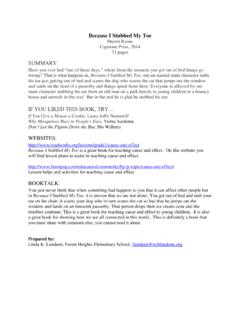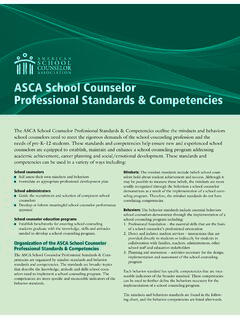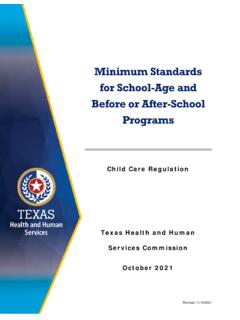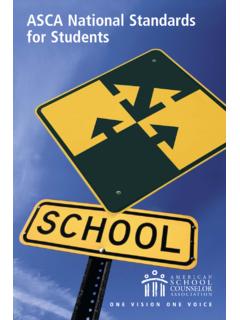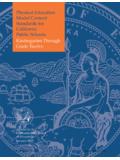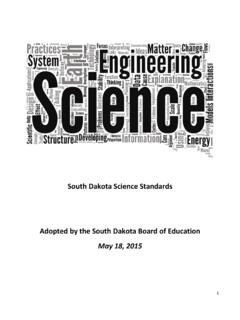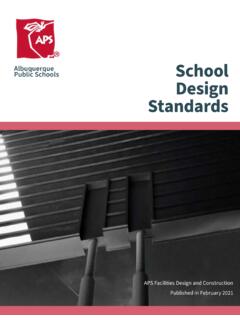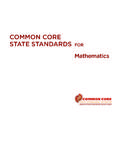Transcription of Standards for School Library Resource Collections
1 South Carolina Standards For School Library Resource Collections South Carolina Department of Education Columbia, South Carolina 2012. Standards Overview All schools regardless of enrollment or grades served should use these core collection Standards for evaluating the Library Resource collection . The results of the evaluation should be used for long-range planning to establish goals for collection development. Standard selection tools and the South Carolina Department of Education (SCDE) collection development guidelines are used to facilitate decisions on acquisitions, weeding, and collection evaluation. (See appendix A for weeding guidelines.). All items available in the Library Resource collection are catalogued and managed with an up-to-date circulation system. The online card catalogue (OPAC) is available on every School computer with local area network (LAN) connectivity. Web-based resources are available at School and beyond the School day providing 24/7 access. The Resource collection is organized with an appropriate system, such as Dewey Decimal System, BISAC (Book Industry Study Group), etc.
2 The collection , regardless of student enrollment or grades served, should have a minimum number of books per pupil; however, no School should be required to have more than 25,000 volumes. At Risk Basic Exemplary A minimum of 15 books A minimum of 11 books A minimum of 13 books per student that meet the per student that meet the per student that meet the Exemplary age At Risk age requirements, Basic age requirements, requirements, are current, are current, aligned with are current, aligned with aligned with the the curriculum, reflect the curriculum, reflect curriculum, reflect students' interests, and are students' interests, and are students' interests, and are age and developmentally age and developmentally age and developmentally appropriate. appropriate. appropriate. With the adoption and implementation of the Common Core State Standards (CCSS), School Library Collections should reflect: o the balance of fiction and non-fiction according to grade bands, and o levels of text complexity.
3 The collection of resources is aligned with the School 's curriculum to support the instructional program of the School and district. These resources also meet the recreational reading needs of the School community. (See appendix B for Resource Alignment through Curriculum Mapping.). Standards for South Carolina School Library Resource Collections 2. No more than five copies of the same print title may be counted to meet standard for minimum number of books per student. Classroom sets may be cataloged into the Library media center Resource database for inventory and accountability purposes but may not be counted to meet standard for minimum number of books per student. Multi-volume sets ( , multi-volume encyclopedias) are counted as one title. The collection provides access to resources as reflected in the following grade band charts. Periodicals available through DISCUS may be counted for up to 50 percent of the number of periodical subscriptions required to meet the standard for number of periodical subscriptions for both the general collection and for the professional collection .
4 Access to SCDISCUS resources for reference and research is implied in each nonfiction category. We recognize that availability to digital materials is an emerging publishing format. Schools can make individual allowances to adjust for the use of these materials. To balance the collection and facilitate collection development the following percentages for the fiction and nonfiction sections are recommended. However, these percentages may vary depending on an individual School 's instructional program. For example, a high School with a strong literacy initiative may need a collection that is 50% fiction and 50% nonfiction. Fiction Nonfiction percentage of collection percentage of collection Grade ranges Common Core Common Core SCDE Standards SCDE Standards Standards Standards Elementary 60% 50% 40% 50%. Middle School 45% 45% 55% 55%. High School 35% 30% 65% 70%. The general Library Resource collection contains fiction books o that are age and developmentally appropriate for the students served.
5 O that are diverse and multicultural in scope;. o that address subjects of interest to the students served;. o that are reflective of current and classic literature; and o that meet the age Standards found in the following grade band charts. The general Library Resource collection contains a combination of non-fiction print and non-print resources o that are aligned with the School 's curriculum;. o that address subjects of interest to the students served;. o that are age and developmentally appropriate for the students served; and o that meet the age Standards found in the following grade band charts. The fiction collection will have an older average copyright date than the non- fiction collection ; however, this collection , like the non-fiction collection , should Standards for South Carolina School Library Resource Collections 3. be evaluated and renewed annually to remove items that are outdated, irrelevant, or damaged beyond repair. Specific recommendations for average age of the fiction section and for annual renewal rates are found in the following grade band charts.
6 The non-fiction collection is evaluated annually to remove items containing obvious factual errors, outdated information, or that no longer meet the current curricular needs, or damaged beyond repair. Specific recommendations for annual renewal rates are found in the following grade band charts. Non-fiction items removed from the collection should be discarded according to district policy or SCDE guidelines, if no district policy is available. (See appendix C for SCDE guidelines for disposing of Library resources.) Non-fiction items deemed too old for the Library Resource collection are likewise too old for general classroom use and should, therefore, be discarded. The following areas of the collection print and non-print resources have been identified as critical areas due to rapidly changing information: political science, economics, science, technology, geography, and travel. These areas should be evaluated, weeded, and renewed annually. Specific recommendations for annual renewal rates are found in the following grade band charts.
7 All electronic resources should be available via the LAN and should be accessible on every computer that has LAN connectivity throughout the School and available during the School day and beyond through 24/7 access. Grade Definitions: Elementary School : Standards for elementary schools were developed for the traditional K-5 School model. Schools that include other configurations (such as pre-kindergarten) in their population should adapt these Standards accordingly to meet the needs of their students. Middle School : Standards for middle schools were developed for the traditional middle School serving grades 6-8. Schools with any grade combination that includes grades 6 through 8 should comply with the middle School Standards with adaptations made to address the Standards for other grades.*. High School : Standards for high schools were developed for the traditional high School serving grades 9 through 12. Schools with any grade combination that includes grades 9 through 12 should comply with the high School Standards .
8 *. * Schools that include middle and high School grades ( , grades 7-12) should meet the high School Standards . Standards for South Carolina School Library Resource Collections 4. ELEMENTARY School Library Resource collection Standards . Kindergarten through Grade 5 (K-5). At Risk Basic Exemplary A minimum of 11 books per A minimum of 13 books per A minimum of 15 books per student. These books should student. These books should student. These books should meet the following age meet the following age criteria, meet the following age criteria, be aligned with the be aligned with the curriculum, criteria, be aligned with the curriculum, reflect students' reflect students' interests, and curriculum, reflect students'. interests, and be age and be age and developmentally interests, and be age and developmentally appropriate. developmentally appropriate. appropriate. Fiction and Nonfiction (Print, Digital and/or Online). At least 1% of the collection At least 3% of the collection is At least 5% of the collection is updated annually.
9 Updated annually. is updated annually. The overall average The overall average copyright The overall average copyright date for the date for the fiction books, copyright date for the fiction books, including including Easy, paperbacks, fiction books, including Easy, paperbacks, audiobooks and ebooks, is no Easy, paperbacks, audiobooks and ebooks, is more than 17 years from audiobooks and ebooks, is no more than 20 years from current calendar date. no more than 15 years from the current calendar date. the current calendar date. The overall average The overall average copyright The overall average copyright date for the non- date for the non-fiction copyright date for the non- fiction books, including books, including Easy, fiction books, including Easy, audiobooks and audiobooks and ebooks, is no Easy, audiobooks and ebooks, is no more than 10 more than 7 years from the ebooks, is no more than 5. years from the current current calendar date. years from the current calendar date. calendar date.
10 The average copyright date The average copyright date for The average copyright date for the total collection is the total collection is 13 for the total collection is 16 years from current years from current calendar 11 years from current calendar calendar 1. Here is the formula used to calculate the average copyright date for the total collection : The collection percentages for fiction and for nonfiction were multiplied by the number of years from current calendar date ( , 20, 17, 5). The results were added together and rounded to the nearest whole number, where necessary. Example: For calculating the total collection average copyright date for the Basic level: 17 (years from current calendar date for fiction section) X .60 (percentage of total collection for fiction section) = years. 7 (years from current calendar date for nonfiction section). X .40 (percentage of total collection for nonfiction section) = years. Add and ( + = ). The average copyright date for the total collection at the Basic Level should be no more than 13 years from current calendar date.
